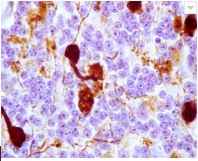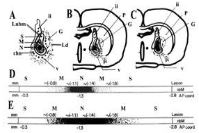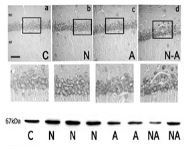LABORATORIES
Involutive and Adaptative Cellular Mechanisms in Neurodegenerative Diseases
Involutive and Adaptative Cellular Mechanisms in Neurodegenerative Diseases
Research
Team
Publications
Contact
Others
Research
Work deals with the study of both the normal and the pathological involution of the Central Nervous System in order to explain the pathogeny of neurodegenerative disorders and to open new therapeutical lines. Studies are carried out in a multidisciplinary approach, using morphological, histochemical and biochemical methods. Human Alzheimer`s and Creutzfeldt-Jakob´s Diseases, sheep scrapie and experimental models of Alzheimer and CNS Oxidative Stress are mainly studied.

Lines of investigation
1) Study on peripheral blood biomarkers (amyloid peptides, oligomers, oxidative stress markers, cytokines, pro-imflamatory system markers, etc.) in humans suffering Alzheimer´s Diseases and related dementias (MCI, vascular and frontotemporal dementias, etc).
Using morphological, histochemical and microspectroscopic methods blood biomarkers are studied to develop diagnostic protocols. Two international patents are being developed.
2) Study of central and peripheral biomarkers in non-human primates and experimental models of Alzheimer´s Disease (transgenic mice) using morphological and histochemical methods to understand the pathogeny of the disease and develop strategies for diagnosis and treatment.
3) Characteristics of the human cerebellar cortex during both normal –senile- and pathological -Alzheimer’s (AD), Creutzfeldt-Jakob (CJD), Familiar Fatal Imsomnia (FFI), as well as of the sheep scrapie.
Morphological and histochemical alterations of both neurons and glial cells in demented (AD, CJD, FFI) and non-demented elderly people, and in sheep suffering scrapie are being studied, for detecting the first pathological changes (pro-inflammatory systems, glial reaction, neuronal apoptosis, etc.) as well as neuroprotective mechanisms (synaptic proteins, neurotrophic systems, etc.)
4) Characterization of Alzheimer experimental models obtained by lesion/dysfunction of the nucleus basalis of the white rat. Long-term evolution (three years).
Alzheimer experimental models have been obtained with rats by stereotaxical unilateral injections of selected neurotoxins (ibotenic, quisqualic and NMDA acids – 7.5 to 100nmols). Both involutive and adaptative changes in the basalo-cortical cholinergic systems and cerebral cortex are being studied.
5) CNS effects of nicotine treatments in normal young and senile rats, and in Alzheimer experimental models.
Different types of CNS effects induced by nicotinic (accute and chronic treatments) in normal and experimental (mainly nbM-lesioned) rats, at different age of life, are being studied to demonstrate the therapeutic properties of the specific stimulation of the cortical nicotinic receptors in Alzheimer’s disease and other less severe cognitive disorders. Several glycolytic and Krebs cycle dehydrogenase activities in the frontoparietal cortex and subcortical nuclei, have increased after acute or chronic nicotine treatments, as well as the neuronal and/or the glial content of some neurotrophic peptides (NGF, VIP, etc.).
6) Primacy of neuroglial alterations (astroglial, oligodendroglial, microglial) in Neurodegenerative Diseases: genesis, development and therapeutic possibilities.
a) Studies in human brains and in models of experimental Alzheimer’s.
b) Study of neuroglial degenerative pathological correlations in these diseases with those occurring in systemic metabolic diseases (obesity, diabetes, insulin resistance).




Team

Adolfo Toledano Gasca
Principal Investigator
Most relevant methodology:
A multidisciplinary (morphological, histochemical –both at the ligt and electron microscopical level-, biochemical) approach. Image analysis and tridimensional reconstruction of normal and pathological structures.
Publications
Representative publications
-
Toledano-Díaz A, Álvarez MI, Toledano A. The relationships between neuroglial and neuronal changes in Alzheimer’s disease, and the related controversies II: gliotherapies and multimodal therapy. J Cent Nerv Syst Dis. 2022 Nov 14;14:11795735221123896. doi: 10.1177/11795735221123896.
-
Toledano-Díaz A, Álvarez MI, Toledano A. The relationships between neuroglial alterations and neuronal changes in Alzheimer’s disease, and the related controversies I: Gliopathogenesis and glioprotection. J Cent Nerv Syst Dis. 2022Oct 9;14:11795735221128703. doi: 10.1177/11795735221128703
-
Toledano-Díaz A, Álvarez MI, Rodríguez JJ, Badiola JJ, Monzón M, Toledano A. Reflections on Cerebellar Neuropathology in Classical Scrapie. Biomolecules. 2021 Apr 28;11(5):649. doi: 10.3390/biom11050649.
-
Toledano-Díaz A, Álvarez MI, Toledano A Glial Alterations in Aging and Alzheimer’s Disease: A Novel Basis to Understand, Prevent and Treat the Degenerative Process. OBM Geriatrics 2020; 4(2), doi:10.21926/obm.geriatr.2002117
-
Merino JJ, Muñetón-Gomez V, Muñetón-Gómez C, Pérez-Izquierdo MÁ, Loscertales M, Toledano Gasca A. Hippocampal CCR5/RANTES Elevations in a Rodent Model of Post-Traumatic Stress Disorder: Maraviroc (a CCR5 Antagonist) Increases Corticosterone Levels and Enhances Fear Memory Consolidation. Biomolecules. 2020 Feb 1;10(2):212. doi: 10.3390/biom10020212.
-
Merino JJ, Cabaña-Muñoz ME, Toledano Gasca A, Garcimartín A, Benedí J, Camacho-Alonso F, Parmigiani-Izquierdo JM. Elevated Systemic L-Kynurenine/L-Tryptophan Ratio and Increased IL-1 Beta and Chemokine (CX3CL1, MCP-1) Proinflammatory Mediators in Patients with Long-Term Titanium Dental Implants. J Clin Med. 2019 Sep 2;8(9):1368. doi: 10.3390/jcm8091368.
-
Merino JJ, Parmigiani-Izquierdo JM, Toledano Gasca A, Cabaña-Muñoz ME. The Long-Term Algae Extract (Chlorella and Fucus sp) and Aminosulphurate Supplementation Modulate SOD-1 Activity and Decrease Heavy Metals (Hg++, Sn) Levels in Patients with Long-Term Dental Titanium Implants and Amalgam Fillings Restorations. Antioxidants (Basel). 2019 Apr 16;8(4):101 doi: 10.3390/antiox8040101.
-
Rodriguez-Casado A, Toledano-Díaz A, Toledano A. Defective Insulin Signalling, Mediated by Inflammation, Connects Obesity to Alzheimer Disease; Relevant Pharmacological Therapies and Preventive Dietary Interventions. Curr Alzheimer Res. 2017;14(8):894-911. doi: 10.2174/1567205014666170316161848.
-
Toledano A, Merino JJ, Rodríguez JJ. Editorial: Neuroglia in Alzheimer’s Disease: From Cohort to Contestant in the Disease Progression and its Therapy. Curr Alzheimer Res. 2016;13(4):318-20. doi: 10.2174/156720501304160314173258.
-
Toledano A, Álvarez MI, Toledano-Díaz A, Merino JJ, Rodríguez JJ. Brain local and regional neuroglial alterations in Alzheimer’s Disease: cell types, responses and implications. Curr Alzheimer Res. 2016;13(4):321-42. doi: 10.2174/1567205013666151116141217
-
Carmona P, Molina M, Toledano A. Blood-based biomarkers of Alzheimer’s disease: diagnostic algorithms and new technologies. Curr Alzheimer Res. 2016;13(4):450-64. doi: 10.2174/1567205013666151116130301.
-
Alvarez MI, Rivas L, Lacruz C, Toledano A. Astroglial cell subtypes in the cerebella of normal adults, elderly adults, and patients with Alzheimer’s disease: a histological and immunohistochemical comparison. Glia. 2015 Feb;63(2):287-312. doi: 10.1002/glia.22751.
-
Carmona P, Molina M, López-Tobar E, Toledano A. Vibrational spectroscopic analysis of peripheral blood plasma of patients with Alzheimer’s disease. Anal Bioanal Chem. 2015 Oct;407(25):7747-56. doi: 10.1007/s00216-015-8940-7
-
Sarasa R, Junquera C, Toledano A, Badiola JJ, Monzón M. Ultrastructural changes in the progress of natural Scrapie regardless fixation protocol Histochem Cell Biol. 2015 Jul;144(1):77-85. doi: 10.1007/s00418-015-1314-6
-
Toledano A, Álvarez MI, López-Rodríguez AB, Toledano-Díaz A, Fernández-Verdecia CI. ¿Existe la enfermedad de Alzheimer en todos los primates? PatologíaAlzheimer en primates no humanos y sus implicaciones fisiopatológicas (II) [Does Alzheimer’s disease exist in all primates? Alzheimer pathology in non-human primates and its pathophysiological implications (II)]. Neurologia. 2014 Jan-Feb;29(1):42-55. Spanish/English doi: 10.1016/j.nrl.2011.05.004
- Toledano A, Álvarez MI, Toledano-Díaz A. Variability in the effects of nicotine on different regions of the brain: changes in the concentration of superoxide dismutase isoforms. Cent Nerv Syst Agents Med Chem. 2014;14(1):10-22.doi: 10.2174/1871524914666140507162907. Hernández RS, Sarasa R, Toledano A, Badiola JJ, Monzón M. Morphological approach to assess the involvement of astrocytes in prion propagation. Cell Tissue Res. 2014 Oct;358(1):57-63.
- Carmona P, Molina M, Calero M, Bermejo-Pareja F, Martínez-Martín P, Toledano A. Discrimination analysis of blood plasma associated with Alzheimer’s disease using vibrational spectroscopy. J Alzheimers Dis. 2013;34(4):911-20. doi:10.3233/JAD-122041.
- Toledano A, Alvarez MI, López-Rodríguez AB, Toledano-Díaz A, Fernández-Verdecia CI. ¿Existe la enfermedad de Alzheimer en todos los primates? ¿Afección de Alzheimer en primates no humanos y sus implicaciones fisiopatológicas (I) [Does Alzheimer’s disease exist in all primates? Alzheimer pathology in non-human primates and its pathophysiological implications (I)]. Neurologia. 2012 Jul-Aug;27(6):354-69. Spanish. doi: 10.1016/j.nrl.2011.05.008.
- Toledano A, Alvarez MI, Monleón E, Toledano-Díaz A, Badiola JJ, Monzón M. Changes induced by natural scrapie in the calretinin-immunopositive cells and fibres of the sheep cerebellar cortex. Cerebellum. 2012 Jun;11(2):593-604. doi: 10.1007/s12311-011-0335-5.
- Carmona P, Molina M, Calero M, Bermejo-Pareja F, Martínez-Martín P, Alvarez I, Toledano A. Infrared spectroscopic analysis of mononuclear leukocytes in peripheral blood from Alzheimer’s disease patients. Anal Bioanal Chem. 2012 Feb;402(6):2015-21. doi: 10.1007/s00216-011-5669-9.
- Toledano A, Alvarez MI, Toledano-Díaz A. Diversity and variability of the effects of nicotine on different cortical regions of the brain – therapeutic and toxicological implications. Cent Nerv Syst Agents Med Chem. 2010 Sep 1;10(3):180-206. doi: 10.2174/1871524911006030180.
- Toledano A, Alvarez MI, Caballero I, Carmona P, De Miguel E. Immunohistochemical increase in cyclooxygenase-2 without apoptosis in different brain areas of subchronic nicotine- and D-amphetamine-treated rats. J Neural Transm. 2008 Aug;115(8):1093-108. doi: 10.1007/s00702-008-0040-9.10
- Carmona P, Rodríguez-Casado A, Alvarez I, de Miguel E, Toledano A. FTIR microspectroscopic analysis of the effects of certain drugs on oxidative stress and brain protein structure. Biopolymers. 2008 Jun;89(6):548-54. doi:10.1002/bip.20944.
- Alvarez MI, Lacruz C, Toledano-Díaz A, Monleón E, Monzón M, Badiola JJ, Toledano A. Calretinin-immunopositive cells and fibers in the cerebellar cortex of normal sheep. Cerebellum. 2008;7(3):417-29. doi: 10.1007/s12311-008-0044-x.
- Carmona P, Molina M, Calero M, Bermejo-Pareja F, Martínez-Martín P, Toledano A. Discrimination Analysis of Blood Plasma Associated with Alzheimer’s DiseaseUsing Vibrational Spectroscopy. J Alzheimers Dis. (2013) Jan 8. [En prensa] PubMed PMID: 23302656.
- A. Toledano, MI. Alvarez, E. Monleón, A. Toledanodiaz, JJ.Badiola, M. Monzon. Changes induced by natural Scrapie in the calretinin-immunopositive cells and fibres of the sheep cerebellar cortex. Cerebellum 11: 593-604 (2012) (on-line DOI 101007/s12311-011-0335-5)
- P Carmona, M Molina, M Calero, F Bermejo-Pareja, P Martínez-Martín, MI Alvarez, A Toledano. Infrared spectroscopic analysis of mononuclear leukocytes in peripheral blood from Alzheimer’s disease patients. Anal Bioanal Chem. 402:2015–2021 (paper in forefront, DOI 0.1007/s00216-011-5669-9) (2012)
- Toledano, A.; Álvarez, M.I.; López-Rodríguez, A.B.; Toledano-Díaz, A.; Fernández-Verdecia, C.I. Does Alzheimer’s disease exist in all primates? Alzheimer pathology in non-human primates and its pathophysiological implications (I) Neurologia (English edition). 27:354-69 (2012)
- Toledano, A.; Álvarez, M.I.; López-Rodríguez, A.B.; Toledano-Díaz, A.; Fernández-Verdecia, C.I. Does Alzheimer’s disease exist in all primates? Alzheimer pathology in non-human primates and its pathophysiological implications (II) Neurología. (English edition) (in press) (2012)
- Toledano, A.; Álvarez, M.I.; Carmona, P.; Toledano-Díaz, A.; Fernández-Verdecia, C.I. Alzheimer pathology in non-human primates and its pathophysiological implications. In: Primates. Classification, evolution and behavior. E F Hughes and M Hill (eds). Nova Sciences Pub. New York, pp 71-110 (2012)
- TOLEDANO A, ALVAREZ MI, LÓPEZ-RODRÍGUEZ AB, TOLEDANO-DÍAZ A, FERNÁNDEZ-VERDECIA CI. ¿Existe la Enfermedad de Alzheimer en todos los primates? Patología Alzheimer en primates non humano y sus implicaciones fisiopatológicas (I). Neurología. (en prensa) (2011)
- Toledano A, Alvarez MI, López-Rodríguez AB, Toledano-Díaz A, Fernández-Verdecia CI ¿Existe la Enfermedad de Alzheimer en todos los primates? Patología Alzheimer en primates non humano y sus implicaciones fisiopatológicas (II). Neurología. (en prensa; on line DOI 101007/s12311-011-0335-5) (2011)
- Toledano A; Alvarez MI; Toledano-Díaz A. Multiple neuronal and glial mechanisms can be involved in the response to the activation of nicotinic receptors. In: A Costa , E Villalba (Eds) Horizons in Neuroscience Research. Volume 3 Neural Transmissions: Characteristics, Mechanisms and Malfunctioning. Nova Science Publishers, Inc. Hauppauge, NY pp 1-34 (2011).
- A Toledano; Álvarez MI. Lesion-induced vertebrate models of Alzheimer Dementia. En PP Deyn, D Van Dam (eds). Animal models of Dementia. Humana Press, 295-345 (2010)
- Toledano A, M.I. Álvarez. (2008) Toledano A, M.I. Álvarez. (2010) Lesion-induced vertebrate models of Alzheimer Dementia. En: De Deyn PP and Van Dam D ( Editores) Animal models of dementia,The Humana Press ISBN:978-1-60761-897-3
- Toledano A, M.I. Álvarez, I. Caballero , P. Carmona , and E. De Miguel. (2008) Immunohistochemical increase in cyclooxygenase-2 without apoptosis in different brain areas of subchronic nicotine- and D-amphetamine-treated rats. J. Neural Trans 115:1093-1108
- Rodriguez-Casado J, Alvarez MI, De Miguel E, Toledano A, Carmona P (2007) Amphetamine Effects on Oxidative Stress and formation of proteic beta-sheet structures as Revealed by FTIR Microspectroscopy. Biopolymers. 86:437-446.
- Toledano A. “El hipotálamo, su complejidad morfofuncional y su capacidad para dirigir los sistemas reguladores del organismo”. En: A. M. Pascual-Leone (ed.) “Mecanismos moleculares y neuroendocrinos del balance energético: Patologías” . Real Academia de Farmacia. Madrid. Pp:61-88 (2005).
- Toledano A., Álvarez M.I., Rodriguez-Muela N. (2005). Alteraciones de los fenómenos de neuroplasticidad en las enfermedades de Alzheimer y Creutzfeldt-Jakob. Interrelaciones con fenómenos involutivos. Fundación Mapfre Medicina. 16:1-14.
- Toledano A. and Alvarez M.I. (2004). Lesions/dysfunctions of the nucleus basalis as Alzheimer’s Disease models: general and critical overview and analysis of model development. Current Alzheimer Res. 1:189-215.
- Alvarez M.I., Lloréns M., Lacruz C. and Toledano A. (2004). Nueva célula “en cepillo” (“brush cell”) o célula monopolar, del cerebelo. Características y posible función. Rev. Neurol. 38:339-346.
- Toledano A. “La coordinación de los profesionales en la Investigación, la docencia y la asistencia socio-sanitaria”. En “Aspectos Socio-sanitarios del Alzheimer.” J. Selmes, F. Zaragozá, A. Toledano, MI. Álvarez, S. Toledano. (Coordinadores) R. Acad. Farm./Fundación Casares Gil (2004).
- Martínez-Rodríguez R., Toledano A., Álvarez M.I., Turégano L., Colman O., Rosés P., Gómez de Segura I. and De Miguel E. (2003). Chronic nicotine administration increases NGF-like immunoreactivity in the frontoparietal cerebral cortex. J. Neurosci. Res. 73:708-716.
-
Turégano L., Martínez-Rodríguez R., Álvarez M.I., Gragera R.R., Gómez de Segura A., De Miguel E. and Toledano A. (2001). Histochemical study of acute and chronic intraperitoneal nicotine effects on several glycolytic and Krebs cycle dehydrogenase activities in the frontoparietal cortex and subcortical nuclei of the rat brain. J. Neurosci. Res. 64:626-635.
-
Toledano A., Álvarez M.I., Toledano-Díaz M.G. and Martínez-Rodríguez R. “Avances en el diagnóstico y en el tratamiento de la Enfermedad de Alzheimer”. En: Peinado MA., Martínez M. y Pedrosa J.A. (Eds.) “Envejecimiento cerebral. Enfermedades neurodegenerativas asociadas”. Universidad Nacional de Educación a Distancia. Madrid, 2001. pp 252-297 (2001).
-
Toledano A., Álvarez M.I., Rivas L., Lacruz C. and Martínez-Rodríguez R. (2000). Amyloid precursor protein in the cerebellar cortex of Alzheimer‘s disease patients devoid of cerebellar ß-amyloid deposits. Immunocytochemical study of five cases. J.Neural. Trans. 106:1151-1169.
-
Pavía J, Alberch J, Álvarez M.I., Toledano A and De Ceballos M.L. (2000). Repeated in vivo intracerebroventricular administration of ß-amyloid 25-35 decreases muscarinic receptors in cerebral cortex. Neurosci. Lett. 278:69-72.
-
Gragera R.R., Martínez-Rodríguez R, Capilla J., De Miguel E., Gomez-Segura I., Muñiz E., Álvarez M.I. and Toledano A. (2000). Localization of glyoxylate-dehidrogenase activity and glyoxylate-complex molecules in the rat prefrontal cortex. Enzymohistochemical and immunocytochemical study. J. Neurosci. Res. 59:561-567.
-
Monzon-Mayor M., Álvarez M.I., Arbelo-Galván J.F., Romero-Alemán M.M., Yanes C, Plaza M.L., Rodríguez J.R., Rodríguez J.J. and Toledano A. (2000). Long-term evolution of local, proximal and remote astrocyte responses after diverse nucleus basalis lesioning (an experimental Alzheimer model). GFAP immunocytochemical study. Brain Res. 865: 245-258.
LIBRO
Toledano A; Älvarez MI; Toledano-Díaz A. Peculiaridades de la Involución Normal y Patológica en Cerebelo Humano. Editorial Académica Española (OmniScriptum Marketing DEU GmbH; Bahnhofstr. 28; D-66111. Saarbrücken. libro-volumen, pp.1-113
Contact
Where to find us
Involutive and Adaptative Cellular Mechanisms in Neurodegenerative Diseases
Instituto Cajal CSIC. Avda. Doctor Arce, 37. 28002. Madrid
Others
Collaborations
-
Hospital Fundación Alcorcón.
-
Hospital General Universitario Gregorio Marañón.
-
Hospital Universitario La Paz.
-
Fundación Alzheimer Spain.
-
Instituto de Estructura de la Materia (CSIC).
-
Departamento de Reproducción Animal (INIA).
-
Departamento de Patología Animal. Facultad de veterinaria. Universidad de Zaragoza.
-
Instituto de Epidemiología. Instituto de Salud Carlos III.
-
Experto del Ministerio de Sanidad para la puesta en marcha del Plan Nacional Alzheimer y de la Estrategia para la lucha contra las enfermedades Neurodegenerativas del Sistema Nacional de Salud
Scientific dissemination
Publications:
- A Toledano, Mª I Álvarez, S Toledano-Díaz (2008) La compleja evolución de la enfermedad de Alzheimer durante sus cien años de existencia: investigación, clínica y asistencia sociosanitaria. Acta Cient Tecnol. 13:31-37(2008)
- A Toledano, MI Álvarez, A Toledano-Díaz .(2007) En el centenario del nobel a Cajal: el mérito y la vigencia de una trascendental obra científica. Acta Cient Tecnol. 12:24-31
- A Toledano. (2007) Cajal: un nobel, una obra científica y una revolución en la historia de la medicina. ACTA 43:9-15
- Toledano A. (2006) Misteriosas y peligrosas enfermedades priónicas o encefalopatías espongiformes transmisibles: nuevos y revolucionarios conceptos en patología. ACTA 41:23-33
- Toledano A., Alvarez M.I., Toledano S. (2004) “El Proyecto REDAFIAL de la Fundación Alzheimer España y su sitio web http://alzheimer.rediris.es.” En “Aspectos Socio-sanitarios del Alzheimer.” Selmes J., Zaragozá F., Toledano A., Álvarez M.I., Toledano S. (Coordinadores) R. Acad. Farm./Fundación Casares Gil
- Toledano A. (2003). La enfermedad de Alzheimer. El difícil equilibrio entre lo específico y lo genérico, lo posible y lo imposible. Acta Científica y Tecnológica. 7:33-40.
Audiovisual courses on Alzheimer’s disease for healthcare personnel. Alzheimer Spain Foundation, Iberdrola Foundation. (Editions 2005-2007)
- “Curso avanzado sobre la enfermedad de Alzheimer para personal sanitario”. A Toledano, MI Álvarez, S Toledano-Díaz. Audiovisual 45 minutos, monografía y colección de diapositivas para apoyo de profesorado.
- “Aproximación al diagnóstico de la Enfermedad de Alzheimer”. A Toledano, MI Álvarez, S Toledano-Díaz. Audiovisual 45 minutos, monografía y colección de diapositivas para apoyo de profesorado.
- “Aproximación al tratamiento de la Enfermedad de Alzheimer”. A Toledano, MI Álvarez, S Toledano-Díaz. Audiovisual 45 minutos, monografía y colección de diapositivas para apoyo de profesorado.
- “Estimulación mental de enfermos de alzheimer: Ejercicios de Terapia Ocupacional”. J Fernández González, A Toledano, MI Álvarez, S Toledano-Díaz. Audiovisual 45 minutos, monografía, cloección de fichas y colección de diapositivas para apoyo de profesorado.
Organization and maintenance of the virtual community http://www.fundacionalzheimeresp.org ( Virtual community with extensive information and training content, 42 web pages, 340,000 visits per year)
Courses and seminars for health personnel dedicated to the care of people with dementia and neurodegenerative diseases.

Neuroscience Research Center dependent on the CSIC. Founded in 1920 and initially directed by Santiago Ramón y Cajal. World reference in the study of the brain. Custodian of the Cajal Legacy.
Activities
